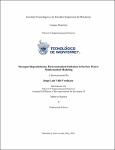| dc.contributor.advisor | López Zavala, Miguel Ángel | |
| dc.contributor.author | Valle Verduzco, Jorge Luis | |
| dc.date.accessioned | 2022-10-25T17:14:24Z | |
| dc.date.available | 2022-10-25T17:14:24Z | |
| dc.date.created | 2021-06-14 | |
| dc.date.issued | 2021-06 | |
| dc.identifier.citation | Valle Verduzco, J. (2021). Paraquat Degradation by Electrochemical Oxidation in Surface Water: Mathematical Modeling (master thesis). Tecnológico de Monterrey. | es_MX |
| dc.identifier.uri | https://hdl.handle.net/11285/649777 | |
| dc.description | https://orcid.org/0000-0002-5166-6983 | es_MX |
| dc.description.abstract | Today’s society must face a series of challenges to ensure continuous survival. In addition, agriculture is one of the main activities in rural areas. In some cases, this is the only possible activity in the economy of these regions and, therefore, the only engine of growth. Pesticides are agents that protect crops from pests and diseases. Paraquat (1,1’-dimethyl-4,4’-bipyridinium dichloride) is a non-selective, contact broad- spectrum herbicide that has been widely used as an herbicide for decades. Paraquat poisoning has a high mortality rate. Several methods have been investigated to remove paraquat from aquatic environments. Currently, adsorption and degradation are the two main methods to remove/reduce paraquat. Solutions of paraquat dichloride tetrahydrate (100%, AccuStandard) were prepared with surface water (“Rodrigo Gomez” dam) with a concentration of 13 mg/L, 14 mg/L and 15 mg/L. Initial pH (8.2) of the solutions was adjusted to 3, 7 and 9. Then, electrochemical oxidation of samples of each solution was conducted at DC densities of 16.29 mA/cm2 (6.5 V), 30 mA/cm2 (12 V) and 60 mA/cm2 (24 V). The reaction times were 1, 2.5, 5, 7.5, 10, 15, 20, 25, 30, 35, 40, 50 and 60 minutes. Paraquat and their transformation products (TP) were analyzed by HPLC using an Agilent 1260 HPLC-DAD equipment (Agilent Technologies, Santa Clara, CA, USA) with a reverse phase Zorbax Eclipse XDB C-18 column with dimensions of 150 x 4.6 mm and 5 µm diameter spherical particles (Agilent Technologies, Santa Clara, CA, USA). All samples were filtered using 0.45µm polytetrafluoroethylene syringe filters before analysis. For the mathematical modeling of paraquat degradation, four scenarios were proposed. The first scenario was anodic oxidation with active electrodes with active hydroxyl radicals, the second scenario was with active chlorine species at pH < 3 with Cl2 (gas), the third scenario was with active chlorine species at 3 < pH < 8 with HClO as oxidant, and the fourth scenario was with active chlorine species at pH > 8 with ClO-. At pH 3 was the only treatment that completely degraded paraquat within 60 minutes since pH 7 and pH 9 did not show complete degradation of the herbicide. From the experiments carried out, the current density of 30 mA/cm2 at pH < 3 was the one that showed the best degradation. The validation of the mathematical model, at a current density of 30 mA/cm2, resulted in a correlation of 94% of paraquat degradation and 95% of Cl2 production (pH < 3). The formulation of ordinary differential equations facilitated the modeling. | es_MX |
| dc.format.medium | Texto | es_MX |
| dc.language.iso | eng | es_MX |
| dc.publisher | Instituto Tecnológico y de Estudios Superiores de Monterrey | es_MX |
| dc.relation | CONACyT | es_MX |
| dc.relation | Tecnológico de Monterrey | es_MX |
| dc.relation.isFormatOf | publishedVersion | es_MX |
| dc.rights | openAccess | es_MX |
| dc.rights.uri | http://creativecommons.org/licenses/by-nc-nd/4.0 | es_MX |
| dc.subject.classification | INGENIERÍA Y TECNOLOGÍA::CIENCIAS TECNOLÓGICAS::INGENIERÍA Y TECNOLOGÍA ELÉCTRICAS | es_MX |
| dc.subject.lcsh | Technology | es_MX |
| dc.title | Paraquat degradation by electrochemical oxidation in surface water: mathematical modeling | es_MX |
| dc.type | Tesis de Maestría / master Thesis | es_MX |
| dc.contributor.department | School of Engineering and Sciences | es_MX |
| dc.contributor.committeemember | García Orozco, Jorge Humberto | |
| dc.contributor.committeemember | Monárrez Cordero, Blanca Elizabeth | |
| dc.identifier.orcid | https://orcid.org/0000-0001-8846-8801 | es_MX |
| dc.subject.keyword | Electrochemical oxidation | es_MX |
| dc.subject.keyword | paraquat | es_MX |
| dc.subject.keyword | anodic oxidation | es_MX |
| dc.subject.keyword | active chlorine species | es_MX |
| dc.subject.keyword | ordinary differential equations | es_MX |
| dc.contributor.institution | Campus Monterrey | es_MX |
| dc.contributor.cataloger | dnbsrp | es_MX |
| dc.description.degree | Master of Science in Engineering Sciences | es_MX |
| dc.identifier.cvu | 1001954 | es_MX |
| dc.date.accepted | 2021-06-08 | |
| dc.audience.educationlevel | Público en general/General public | es_MX |
| dc.identificator | 7||33||3306 | es_MX |




